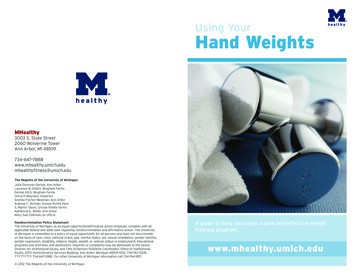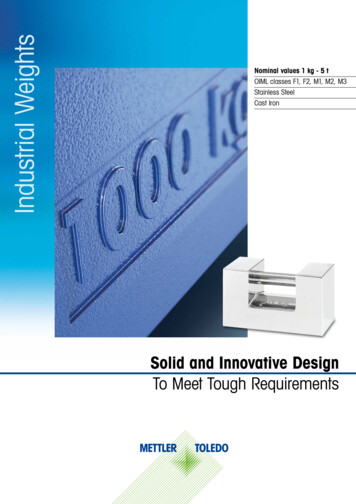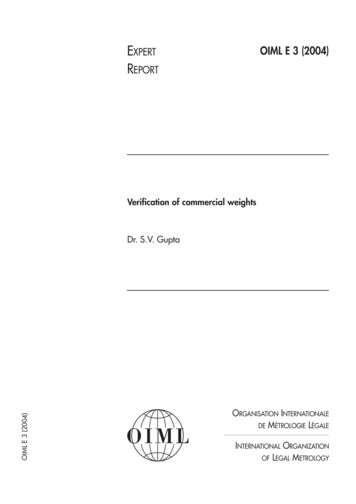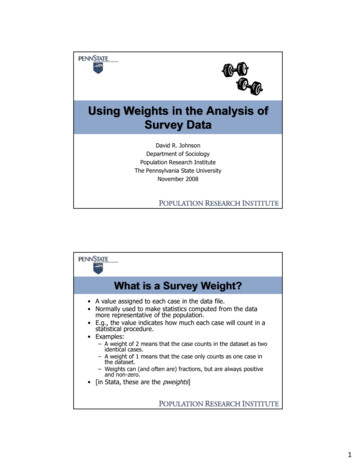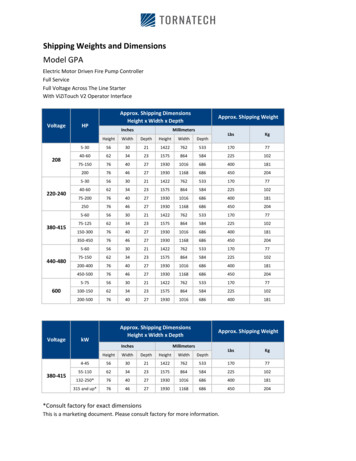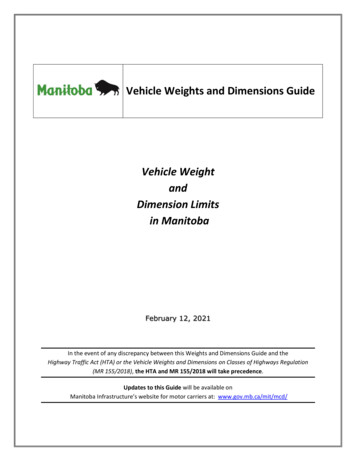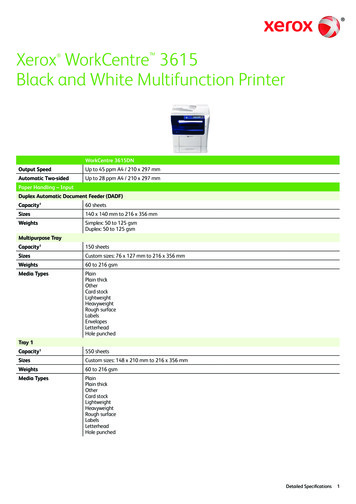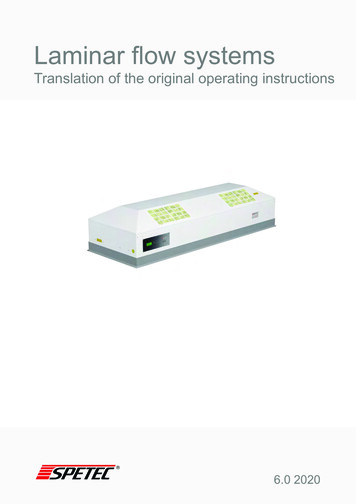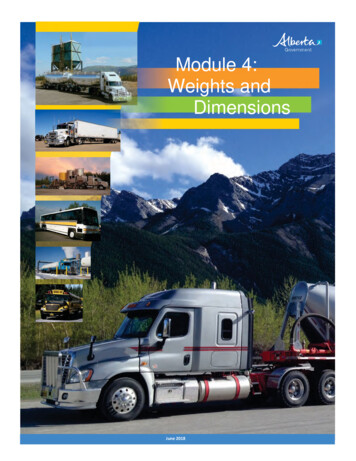
Transcription
Module 4:Weights andDimensionsJune 2018
MODULE 4: WEIGHTS AND DIMENSIONS2MODULE CONTENTSModule 4 aims to provide carriers with basic information about vehicle weights and dimensions. Thecontents of this module are as follows.Vehicle Weights and DimensionsMaximum Allowable Weight CalculatorSigns on VehiclesVehicle DimensionsPermitsOverdimensional Safety RequirementsEscort Vehicle RequirementsGetting Permits OnlineRoad Restrictions and Seasonal RoadBans Resources for Carriers3456789101214This is a guide only and is not meant to be a substitute for the actual legislation.Commercial Vehicle Safety Compliance in AlbertaLast Updated: June 2018
MODULE 4: WEIGHTS AND DIMENSIONS3VEHICLE WEIGHTS AND DIMENSIONSLegal WeightsProvinces and territories have laws that establish maximum vehicle weights. This is to ensure publicsafety and to protect Alberta’s highway infrastructure. A carrier must comply with all weightrestrictions for the roads they operate on. In Alberta, legal weights depend on different things such asthe type of vehicle, the number of axles on the vehicle, the manufacturer’s rating and the size of thetires on the vehicle.A quick reference guide to Alberta’s weight regulations for common vehicles and equipment isavailable online at: www.transportation.alberta.ca/4777.htm.Carriers must be aware of weight restrictions that may apply to their vehicles. There is a calculatoravailable on the website mentioned above which may help a carrier determine whether their vehiclesmeet the maximum allowable weight according to Alberta laws.Commercial Vehicle Safety Compliance in AlbertaLast Updated: June 2018
MODULE 4: WEIGHTS AND DIMENSIONSCommercial Vehicle Safety Compliance in Alberta4Last Updated: June 2018
MODULE 4: WEIGHTS AND DIMENSIONS5Signs on VehiclesOnce a carrier has calculated the weight of their vehicle, they must place signs on it.According to Schedule 1, Section 9 of the Commercial Vehicle Safety Regulation (AR121/2009),commercial vehicles that are weighing or registered for more than 4,500 kilograms must have thefollowing information displayed on the left and right sides of the vehicle: The name or registered logo of the vehicle’s owner;The vehicle’s TARE weight;The licensed maximum gross weight of the vehicle (GVW).The TARE weight of a vehicle means the weight of the vehicle when it is empty or not carrying cargo.The GVW of a vehicle means the licensed maximum weight of the vehicle as per the vehicle’scertificate of registration.The letters and numbers listed on the side of a vehicle must be atleast 50 millimeters in height. They must also be a different colorfrom their background so that the information is clearly visible. Allinformation listed on the vehicle must be accurate.A commercial vehicle must not be operated on a highway unlessthe owner of the registered vehicle has correctly decaled the sidesof it.Some exemptions do apply. Refer to the Commercial Vehicle Safety Regulation (AR121/2009) for details.Commercial Vehicle Safety Compliance in AlbertaLast Updated: June 2018
MODULE 4: WEIGHTS AND DIMENSIONS6Maximum DimensionsA carrier must also be aware of the actual size of their vehicle and load asmaximum dimensions apply. If a vehicle or its load is too tall or too wide, itmay not be able to travel on certain routes because of the heights of bridgesand the width of roads.A quick reference guide to Alberta’s dimension limits for common vehicles andequipment is available online at: www.transportation.alberta.ca/4777.htm.Summarized, the maximum dimensions of common commercial vehicles inAlberta are as follows:Width: 2.6 metres (8’ 6’’)Height: 4.15 metres (13’ 6’’)Length: Single VehicleTruck-Tractor and Semi-TrailerTruck in Combination, Truck and PonyTrailer, Truck and Full TrailerTruck-Tractor, Semi-Trailer and FullTrailer or Semi-Trailer in Combination12.5 metres (41’ 0’’)23.0 metres (75’ 6’’)23.0 metres (75’ 6’’)26.0 metres (85’ 3’’)Provincial laws related to legal weights and dimensions in the trucking industry are available in paperand electronic format through the Alberta Queen's Printer Bookstore. Refer to the Introduction forcontact information.Carriers may be eligible to obtain permits for the movement of vehicles or loads that exceed themaximum dimensions or maximum legal weights.Commercial Vehicle Safety Compliance in AlbertaLast Updated: June 2018
MODULE 4: WEIGHTS AND DIMENSIONS7PERMITSVehicles that exceed the maximum allowable weights or dimensions may be allowed to operate if acarrier gets a permit. The Alberta government monitors, controls and issues permits for the movementof all overweight or overdimensional commercial vehicles. This is done for the following reasons: To ensure the safety of the traveling public;To minimize the inconvenience to the traveling public;To protect Alberta’s infrastructure (roads and bridges);To assist in the movement of items that cannot be divided or are not economical totransport at legal dimensions;To establish and communicate to the carrier a set of conditions for the safe movement of aload.ConditionsConditions are applied to permits to enhance public safety. They often include things such as addingextra signage to vehicles which have exceeded the weights and dimensions in regulations. A summaryof conditions may be found on the next page.Carriers who are issued a permit must ensure they and their drivers readand follow all applicable conditions.Commercial Vehicle Safety Compliance in AlbertaLast Updated: June 2018
MODULE 4: WEIGHTS AND DIMENSIONS8OVERDIMENSIONAL SAFETY REQUIREMENTSWhen a carrier operates a commercial vehicle under the authority of an overdimensional permit, theymust meet all relevant safety requirements in Part 4 of the Alberta Commercial Vehicle Dimension andWeight Regulation (AR 315/2002):VEHICLE DIMENSIONSREQUIREMENTSOver 2.60 metres wide (8’ 6”) Vehicle equipped with flags by day;Vehicle equipped with warning lights by night orduring adverse weather conditions.Over 3.05 metres wide (10’) Over 3.35 metres wide (11’)Over 3.85 metres wide (12’ 6”) As above PLUS 2 dimension signs at the front and backof the vehicle in a manner that is clearly visible toapproaching traffic.As above PLUS 1 or more flashing lights.As above PLUS 1 pilot vehicle behind when on 4-laneroad or 1 pilot vehicle in front when on 2-lane road;No movement from 3:00pm until midnight on a Fridayor a day preceding a statutory holiday;No movement on a Sunday or a statutory holiday.Vehicle equipped with flags, signs, and flashing lights;On 2-lane road, need 1 pilot and 1 trailing vehicle;On 4-lane road, vehicles up to 5.5m wide (18’) need 1trailing vehicle;On 4-lane road, vehicles over 5.5m wide need 1 pilotand 1 trailing vehicle;No operation on highway from 3:00pm until midnighton a Friday or a day preceding a statutory holiday;No operation on highway on Sunday or a statutoryholiday;Travel during DAYLIGHT HOURS ONLY. Over 4.45 metres wide (14’ 7”) Over 5.5 metres wide (18’) Over 5.3 metres high (17’ 4”) As above PLUS other conditions as specified on thepermit;Stopping on provincial highways only permitted atdesignated truck pull-outs (except for emergenciesand power line lifting);Travel during DAYLIGHT HOURS ONLY.Notify power and telephone companies;Travel during DAYLIGHT HOURS ONLYIn addition to these requirements, carriers must also follow all conditions that are listedon their overdimensional permit.Commercial Vehicle Safety Compliance in AlbertaLast Updated: June 2018
MODULE 4: WEIGHTS AND DIMENSIONS9ESCORT VEHICLE REQUIREMENTSAccording to Part 4 of the Alberta Commercial Vehicle Dimension and Weight Regulation (AR315/2002), when an overdimensional vehicle must be accompanied by an escort vehicle, the followingrequirements must be met:Travel Requirements 2-way radio communication between the escort vehicle and the overdimensional vehicle mustbe maintained at all times;A pilot vehicle accompanying an overdimensional vehicle must precede it at a distance of 300to 1000 metres;A trail vehicle accompanying an overdimensional vehicle must follow it at a distance of 100 to300 metres;The escort vehicle must not tow any trailer or other vehicle, or carry a load that obscures anyequipment the vehicle is required to have.Equipment Requirements Escort vehicles must be equipped with a dimensional sign (as shown in Schedules 4 and 5 ofthe regulation) that is visible from both the front and rear of the vehicle;An escort vehicle must carry at least the following equipment:ooooo3 approved warning devices;3 warning flags for traffic marking;1 warning flag per crew member for flagging;One reflective vest per crew member;One flashlight per crew member.For the full requirements, refer to Part 4 of the Alberta Commercial Vehicle Dimension and WeightRegulation (AR 315/2002).Commercial Vehicle Safety Compliance in AlbertaLast Updated: June 2018
MODULE 4: WEIGHTS AND DIMENSIONS10GETTING PERMITS IN ALBERTA: ONLINE SERVICESThe Alberta government has an online system which allows carriers to quickly and easily apply forpermits. Carriers may also check the status of applications and permits which they have already sent in.Once a carrier has registered for Alberta Transportation Online Services, they will be able to access thewebsite at www.trans.gov.ab.ca/TravisWebLogin/redirect.htm using their Log-in information.More information about Alberta Transportation Online Services is available online .Obtaining PermitsCarriers may apply for the following permits:Web Enabled Permits(applications must be sent over the internet, either by acarrier or through a third party agency)1.2.3.4.5.6.7.8.9.10.11.12.Single trip overweightDrilling rig overweightMulti-trip overweightSingle trip overdimensionMulti trip overdimensionTAC (tridems on local roads)Seasonal log haul dimensionalSalvage log haul dimensionalSingle trip licensing30/60/90 day licensingWinter log haulFleet tridrive exemption permitNon-Web Enabled Permits(applications must be sent to the Central Permit Office,either by a carrier or through a third party agency)1.2.3.4.5.Equipment exemptionRoad ban exemptionLog haul permits (selected configurations)Resource Road Log HaulAnnual steering axle overloads6. Public entertainment vehicleCommercial Vehicle Safety Compliance in AlbertaLast Updated: June 2018
MODULE 4: WEIGHTS AND DIMENSIONS11TRAVIS Multi-JurisdictionA permit system called TRAVIS Multi-Jurisdiction (TRAVIS-MJ) was developed as part of AlbertaTransportation’s Online Services to simplify permit applications for carriers who operate in more thanone jurisdiction. In the past, carriers had to obtain provincial permits as well as permits from each localroad authority.TRAVIS-MJ allows carriers to apply for and more quickly obtain permits that cover both provincialhighways and local roads of participating municipalities that oversize loads travel on. Rather thanhaving to carry multiple documents, carriers are issued a single document with all required permitapprovals and conditions.More information about TRAVIS-MJ is available online hird Party AgenciesThird party agencies may assist carriers with their permit applications for a fee. These agencies can putall permit application data into Online Services for the carrier. More information on using approvedthird party agencies is available online at: r more information on obtaining permits, contact the Transport Engineering Central Permit Office:BUSINESS HOURS6:00 am - 12:00 am Monday to Friday7:00 am - 10:00 pm Saturday and SundayToll mmercial Vehicle Safety Compliance in AlbertaLast Updated: June 2018
MODULE 4: WEIGHTS AND DIMENSIONS12ROAD RESTRICTIONS AND ROAD BANSSometimes the roads in Alberta are restricted because of things such as: Construction and road maintenance;Seasonal conditions such as spring thaw;Dimensional restrictions (due to overhead structures and bridges);Weight restrictions (due to the maximum weights that bridges or otherstructures are capable of holding).Carriers should always be aware that road restrictions or bans may change, which may result in thecarrier having to change their route.Information about these restrictions is available on the Alberta Transportation website at:www.transportation.alberta.ca/522.htm.Long Combination Vehicle (LCV) Permits and RoutesSection 62 of the Traffic Safety Act gives the Registrar authority to issue permits to carriers so they mayoperate Long Combination Vehicles (LCV). A Long Combination Vehicle is a truck tractor with two orthree trailers. The number of trailers in the combination or the combined length of the truck andtrailers exceed legal dimensions (26 metres in length for A and C trains, 27.5 metres for B trains).Applications for permits allowing the operation of an LCV and the conditions of those permits areavailable on the Alberta Transportation web site at: www.transportation.alberta.ca/3191.htm.Commercial Vehicle Safety Compliance in AlbertaLast Updated: June 2018
MODULE 4: WEIGHTS AND DIMENSIONS13High Vehicle Permits and RoutesThe High Load Corridor is a set of highways within the Province of Alberta which accommodateextremely high or wide loads. Permits for moving such loads through this corridor are required fromthe Alberta government.A map of the corridor and the fees are available on the Alberta Transportation web site l Vehicle Safety Compliance in AlbertaLast Updated: June 2018
MODULE 4: WEIGHTS AND DIMENSIONS14RESOURCES FOR CARRIERSFor a better understanding as to how weights and dimensions regulations affect their operations,carriers may wish to refer to these resources for more information.ResourceWeb LinkCommercial Vehicle Dimension and WeightRegulation (AR 315/2002)www.qp.alberta.ca/1266.cfm?page 2002 315.cfm&leg type Regs&isbncln 9780779775439Alberta Transportation: Weights and /3870.htmCommercial Vehicle Safety Compliance in AlbertaLast Updated: June 2018
Maximum Dimensions . MODULE 4: WEIGHTS AND DIMENSIONS. 6 . A carrier must also be aware of the actual size of their vehicle and load as maximum dimensions apply. If a vehicle or its load is too tall or too wide, it may not be able to travel on certain routes because of the heights of bridges and the width of roads.
